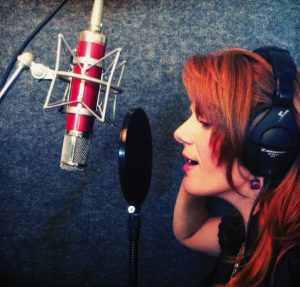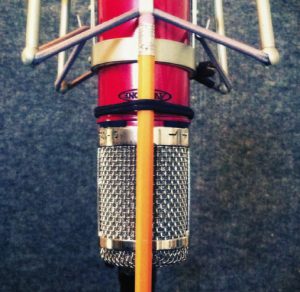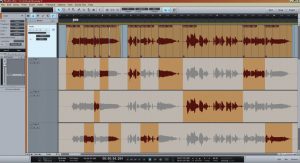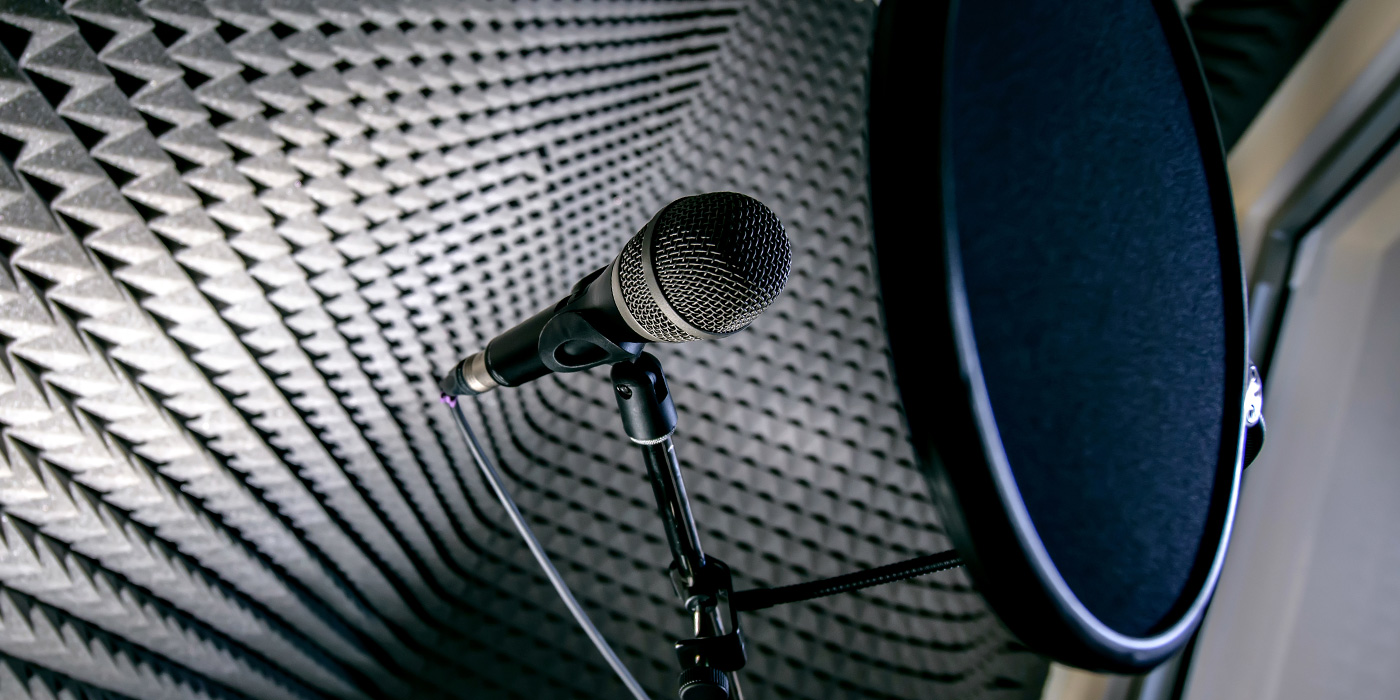From start to finish, here’s how to get that keeper vocal track in your home setup!
By Sven-Erik Seaholm
The human voice is easily the most recognizable of sounds, at least to other humans. Even before we are born, we listen for, recognize and respond to our own mother’s speech and inflections. In pop music, from Rock to Rap or Rhythm & Blues, we still find ourselves instinctively searching for that fundamental element. While the magic of music lies in its power to imply or inspire a wide array of feelings and emotions, when it comes to details and specifics, only words will do.
This places a great deal of importance on the quality of the vocals, both performance-wise and in a technical sense. No matter how great the song, groove and arrangement are, it can all be quickly undone by the entrance of a weak, pitchy, or poorly recorded vocal performance.
In the recording process, the only surprises we’re looking for are pleasant ones. A consistent approach helps to minimize unforeseen distractions that can eat up precious time and energy. There are many facets to this, including the recording environment, the choice of microphone, preamps, headphones, effects and the physical comfort and wellness of the singers themselves. While each voice is as unique as the individual that possesses it, there are measures you can take to minimize the negative aspects, while maximizing your listeners’ enjoyment.
The space is the place
It all begins with where the singer will be performing. Most home studios don’t have an acoustically treated isolation booth available, or even a room besides the area we’ve set aside to record in. The first consideration, then, is determining what this available space sounds like and how it influences the sounds generated within it.
Reflections coming off walls and windows can affect things in drastic ways, multiplying some frequencies or canceling out others due to the sound bouncing off hard surfaces and arriving at the microphone slightly later. This is why iso booths are so ‘dead’ sounding: they’re essentially taking the influence of the room out of the equation.
There are a number of ways home recordists can address this phenomenon. Moving the mic as far away from the walls as possible is a good idea. Treating those walls with sound-absorbing materials like blankets, carpet, and foam are equally time-honored solutions (although these tend to deaden highs and leave lows unaffected, and the non-foam solutions are fire hazards). Closets work great—provided there’s enough space to keep things from becoming too claustrophobic!—due to the sonic damping qualities of the clothing. If you’re looking for something that’s more ‘pro’ in looks, performance, and safety, check out solutions from Auralex, GIK Acoustics, Primacoustic, and other vendors.
A more portable (and slightly easier to install) fix is a reflection filter, which surrounds just the microphone with acoustically absorbent materials; it’s essentially a tiny vocal booth that you can pick up with one hand and attach to a mic stand. Besides the smaller footprint, the added benefit is a reduced amount of ambient noise (computers, air conditioners, etc.) coming in as well. sE Electronics made and still sells the first Reflexion Filter which gave this type of product its name; many competing models are made by companies ranging from Primacoustic and Auralex to Aston Microphones, whose Halo is quite popular now.
Mic check… 1, 2, 1, 2
Once you’ve got the actual vocal recording area established, it’s time to set up a microphone. There are several types to choose from and no one mic will be exactly right for every given situation. That said, large-diaphragm condenser types are generally the most suited to vocals, due to their extended frequency response and ability to capture subtle nuances. This can make them very versatile too, which is a consideration if you’ll need to be using it to record other instruments as well, i.e. acoustic guitar and small percussion instruments like shaker eggs and tambourines. They do however, require phantom power from a preamp or mixer to function. Tube condenser mics don’t, because they use their own power supply to power the tubes, which can impart a bit more warmth to recorded sources in the process.

Figure 1
Some condenser models also offer selectable polar patterns like omni and figure-8, which actually bring the room back in to the sound. Omni mics also minimize the proximity effect, the increased bass response that comes from getting closer to the mic in the standard cardioid pattern. There are many great condenser mic manufacturers to choose from, with AKG, Aston, Audio-Technica, Avantone, Blue, Earthworks, LEWITT, MXL, Neumann, Roswell Pro Audio, Sennheiser, Shure, Sontronics, and Telefunken among many fine choices.
A pop filter is a necessity as well, and its proper placement is key (see Figure 1). It should be set parallel to the mic’s diaphragm, at a distance that not only provides protection from plosives (‘P’s, ‘D’s ‘B’s ‘Fr’s and other blasts of air), but keeps your vocalist from “eating the mic” by standing too close to it.
Position the mic so that the diaphragm is pointing comfortably toward the singer’s lips. It should be high enough to keep the singer from slouching, but not so much that he or she is straining to reach it. I often tilt it slightly downward as well (see Figure 2), which picks up more chest tones and helps minimize plosives.

Figure 2
Dynamic mics like the Shure SM58 can make a fine choice when dealing with exceptionally “bright” voices or aggressive musical styles, such as Metal, Indie Rock or Rap. In fact, many successful singers like Bono and Björk often use them when recording, because they are familiar and stand up well to handling noise. This allows them to ‘perform’ in the studio much as they do in concert.
While it is certainly true that professional results can be obtained using “ordinary” microphones, the best advice is to purchase the best microphone and cable you can reasonably afford for this important task.
Preamps, EQ, and compression
The next link in the vocal recording chain is the preamplifier. Microphones typically have very low output levels. A preamplifier (or preamp) increases this signal to line level, the signal strength required by effects and other devices in your signal chain.
For many of us, the only preamp available is the XLR mic input on our mixer or digital audio interface. There is generally an associated Trim or Gain knob for fine tuning just how much the signal is boosted. Most likely, there is a single red LED light that will illuminate when your signal is clipping, exceeding the recommended level and causing distortion. Having the singer go through some of the loudest passages during setup will help you to find this level, at which point you can turn it down slightly until the clipping disappears. The quality of your preamp can’t be overstated, because an inferior one can degrade the sound of even the best microphone.
EQ (or equalization) is the salt and pepper in your sonic pantry. Some microphones sound great right out of the can, while others could use a little more or less of certain frequencies. You might want to add a bit of ‘air’ around 12 kHz, for example, while de-emphasizing muddiness by pulling things down 2 or 3 dB at 250 Hz.
Less is definitely more when it comes to EQ and if you can get by without it at this stage, all the better. Why? Because EQ is yet another form of distortion. You are permanently altering the signal by moving these frequencies (and some of their neighboring ones) around and potentially creating other problems in the process. Too much salt or pepper can’t be easily undone, and putting off some EQ decisions until after tracking helps us get the seasoning just right. It also provides a clear path “back to square one”, in case we wander too far away from the point at which we started mucking about in the first place.
Compression is another wonderful tool fraught with potentially damaging side effects. A compressor reduces the difference between the loudest and softest portions of your signal. One of the main benefits of using compression is that you can place your vocal much higher in the mix without having it jump out at the listener. The right amount just sounds “mo’ better”. but too much of this good thing can squeeze all of the life right out of a performance.
At first, using a compressor can feel about as intuitive as flying a helicopter! There are several parameters that need to be set and each of them affects the others: Input Gain brings your signal to the optimal level where the compressor can see it. Threshold is the point at which the compressor starts to do its work. Think of it like the height line at amusement-park attractions: everything above this line gets on the ride, everything below it remains unaffected.
Ratio controls how much you attenuate the signal, once it rises above the threshold. A ratio of 2:1 means that for every 2d B of volume increase above the threshold, the perceived volume increase is only 1 dB. A ratio of 4:1 signifies an even more drastic reduction in volume, because for every 4 dB jump in volume, it’s being heard as a 1 dB jump. Considering that 3 dB is essentially twice as loud as 1 dB, a ratio of 3:1 renders your peaks half as loud as they would be without compression. Compression ratios of 10:1 or more (up to infinity:1) are actually called limiting, creating a ceiling above which the signal never rises; this is usually used in mastering to prevent digital overloads that cause loud distortion, but has musical uses as well.
Attack is the time it takes for the compression to kick in. This controls the amount of transients you’re allowing to pass though before turning down (or attenuating) the signal. Slightly longer attacks allow the initial smack of a drum or pluck of a bass string to get through before the body of the note is compressed, giving a feeling of more “punch”, while shorter ones can smooth over plosives and spittiness in a vocal.
Release defines how quickly the compressor “lets go” of the signal, returning it to its normal state. You may have heard of compressors exhibiting “pumping” or “breathing”. This refers to the volume constantly rising up at the end of notes, as the compressor releases the signal. Slower release times make this anomaly less noticeable, but a fast release can be used at quicker tempos.
There are two basic types of compression knees, which are labeled simply enough “soft” and “hard”. Hard knees are easier to explain, in that they work pretty much as I’ve described to this point; everything above the threshold gets squashed by the amount you’ve set your ratio to. Unfortunately, this can be less “musical” sounding than a soft knee compression slope. Soft knee means that the dividing line between compression and no compression is rounded off, so that compression comes in at a lower ratio right near the threshold. This makes for a less noticeable effect upon the signal. Used on vocals, the net result might be described as more “natural” sounding.

Figure 3
Finally, Output (or Makeup) Gain simply takes your effected signal and turns it back up to an optimal level. Since compression lowers overall signal levels, makeup gain assures that your signal’s as loud, on average, coming out of the compressor as it was going in.
De-Essing is a related form of this effect; it’s a form of sidechain compression, which affects only a narrow frequency band. De-essers are usually set between 4–9 kHz to combat excessive sibilance (‘S’, ‘Sh’, and ‘T’ sounds). As useful as this is, it’s also advisable to skip this step during tracking, as it is very easy to overdo it and end up giving your vocalist an unwanted lisp. I generally wait until mixing to employ this effect. A great ‘old-school’ solution is to attach a pencil to the front of the mic with a rubber band, at the center of the diaphragm (see Figure 3). This can work wonders on taming those pesky ‘hot spots’, while retaining the sonic character of your mic.
Many manufacturers include preamps, EQ, and compressors housed within a single unit. These are commonly called recording channels. This all-in-one approach streamlines and simplifies the vocal chain, reducing the amount of time spent patching cables and tweaking parameters. Great examples of these are the PreSonus Eureka and Studio Channel, Universal Audio’s 6176 and the Joemeek oneQ2.
Let’s get physical—advice for the vocalist
It can’t be overstated that singing and/or rapping is a mental, spiritual and physical endeavor. Just as an athlete needs to train, practice, and rest for a big game, so too does a vocalist. Some folks seem to only sing at the gig or in the studio, even though their ‘instrument’ is always at hand!
My advice to them is always, “Sing!” Sing in the shower, sing in the car, spit rhymes while you’re walking or working alone. You need to have an intimate knowledge of your voice and everything it can do. Solo a cappella singing helps us to define our pitch relationships and at the same time, strengthens muscles and builds confidence. Practice supporting your breathing from your diaphragm. Try holding out notes at low volumes, focusing on keeping the pitch steady. Try them with vibrato and without. Try to explore horn-like sonorities and other timbres to find your own unique set of tones and textures. Most of all, sing the songs you’re going to record. The vocalists who come in and get those magic takes most quickly are rarely the most talented ones; they’re simply the most prepared.
Pre-session concerns extend to diet and other activities as well. Avoid greasy foods, sugars and especially dairy products prior to a session, as these all contribute to phlegm and mucous issues, as does smoking. Drinking alcohol may well make a vocalist less inhibited, but that usually comes at the price of fatigue and poor intonation. No one’s asking you to become an angel overnight, but when it’s time to sing in the studio, it’s time to set some vices aside.
Lots and lots of water should always be on hand, and don’t be shy about suggesting a sip between takes. This not only helps prevent fatigue, but keeps vocal chords clean and lubricated. It also improves one’s energy and mental acuity. Some vocalists prefer to have hot tea or coffee, but these can dehydrate as well. Hot water alone can really do the trick in some cases.
Can you hear me?
Once you’ve got everything in place, including a music stand for lyric sheets and the right amount of light, it’s time to don the headphones. If your vocalist is in the same room as you, you’ll both need to be wearing them in order to keep the backing tracks from bleeding into your vocal takes. Most mixers and recording interfaces have one or two headphone outputs, which (in addition to a headphone extension cable) may be all you need. Those needing a few more headphone outputs may need to turn to a headphone distribution amplifier, like the ART HeadAmp, Mackie HM4, or PreSonus HP60.
The vocalist should be able to hear themself clearly in relation to the track. Some even prefer to take off one earcup for monitoring. If they do this, be sure to have the singer close off the unused earcup against their skull or neck, so that the ‘phones don’t bleed or cause feedback. You can also pan all audio to the side in use, so the other earcup gets no audio. Also be aware of “crunchy” sounds coming from the headphones themselves, as all that plastic and faux-leather can be as noisy as your grandma’s vinyl-covered couch!
Adding some (non-recorded) reverb on the vocals can inspire confidence and make your vocalist less self-conscious, but try to use as little as possible; I personally find people sing much more in-tune without it.
Vibe is king
Let’s roll! The best advice to give your vocalists at the start of the session is… nothing. Let them settle in and get used to the situation. Even if they come in at the wrong place, or start with the wrong lyrics… whatever. Just let it slide for right now.
Why? Because instructions bring the thought process into what should ideally be a ‘feel’ process. As soon as someone begins to actually think about what they’re doing, it can come at the cost of some of the more creative and intuitive aspects, like emotion and improvisation. This is why some of the first takes are the ‘magic’ ones. Once singers begin to analyze their performance, they’ll keep score of all the negative things that happen as much as the positive.
Your job, aside from making sure to record even warmups and runthroughs, is to encourage them. Everything you tell your vocalists will take on added significance once they feel they are under the proverbial microscope. Choose your words carefully and render them with empathy. Let them feel that you are in this together, which in fact you are. As frustration levels climb, tempers can flare and sessions can end abruptly. It’s imperative that you keep things running as smoothly as possible. Be of service to them, so that they may be of service to the song.
Begin by running takes from beginning to end, so that you record full performances in each pass. For one, you’ll be able to see where the vocals are supposed to come in, where the verses and choruses are, etc. You will also be getting vocal takes that are emotionally in context. Just as a story develops as it unfolds, so does a song. As a result, your third chorus may differ significantly from the first one, as the tune progresses.
Once you’ve recorded two or three takes, you can then go through and address problem areas. Maybe you’ll go over the hook a couple more times, or punch in to fix that one line in the bridge, etc., until you’re sure that you’ve got all the material you’ll need to edit together a solid, cohesive performance.
Slicing & dicing
This process of stitching all the best bits from multiple takes into one master vocal track is often referred to as comping. “Wait, that’s cheating,” I occasionally hear people say. To them I say this: If my job is to capture you and your sound, I want to be sure I’m representing you on your very best day.
“But we only do one take when we play live,” is often the response. Yes, but your audience only hears it that one time at a show. Conversely, a recording is meant to be enjoyed over and over again, which can magnify even the smallest flaws and detract from the overall listening experience.

Figure 4
This first thing to do is listen through the takes and find the one that sounds best overall. This will be the foundation of your master take and you’ll be bringing in pieces from the other takes to replace sections, lines, words and even syllables. See Figure 4 for a sample section of a vocal comp in PreSonus Studio One. The process is actually simple, if not always easy, and it can be a bit time-consuming as well. Break it down into multiple passes, to remain focused and retain perspective.
During the first pass, listen to the overall performance and flow. You may hear a line and wonder if there’s a better version of it in another take. Audition them until you find one you’re satisfied with, cut and paste it into place. Go back a few measures before that section and play it so you can hear the edit in context. If it sounds good, continue on. Repeat this process until you’ve gone through the entire song, and then play the whole song back, making notes of edits that maybe don’t work as well and find suitable alternatives to put in their place.
On the next runthrough, we focus on the details. Solo the vocal track and listen for clicks, bumps, crackles and less-than-perfect edits. Remove the audio gremlins. Delete or mute areas where there are no vocals, taking care to tame or even eliminate breaths. Great care should be taken not to suck the life out of the performance by editing things too tightly; ideally, you’ll take out what’s distracting while leaving the positive human elements in place. All edits should be as smooth and natural sounding as possible. If you run into one you just can’t get 100% right, take the track out of solo mode and listen to it in context. You may discover that it sounds just fine. If not, try a different take or have the vocalist re-sing it.
The final vocal editing pass concentrates on intonation—making sure the vocal is in tune. If there’s a note that’s a little off key, I prefer to open it in Celemony Melodyne, or tune the note “by hand” by slicing the clip at each end and transposing it up or down by a very small percentage until it sounds right. Celemony Melodyne, Antares Auto-Tune, or similar products can be used over the whole track if you want, but getting it close first minimizes the Cher or T-Pain effect (unless of course that’s what you want) that comes as a result of making the tuner work too hard.
The Sugar
Finally, we sweeten the vocal, polishing it with a little EQ, maybe a touch more compression or limiting, some subtle de-essing, and subsequently adding some reverb and/or delay to add a sense of space and dimension. We want the vocal to sit prominently in the mix, but we need it to blend with the other tracks as well. Too much vocal level can make it sound disconnected or even obscure other crucial elements in your arrangement. Too little can diminish its power or leave listeners scrambling to find a lyric sheet.
When mixing, it’s always important to remember that the elements within your mix are not merely placed between the left and right of your stereo field, but front to back as well. Reverb can help us to further establish this sense of depth.
Faster tempos and dense arrangements will generally require smaller spaces and shorter decay times, while ballads and lower track counts can afford us a little more sonic “elbow room”. This is where presets can come in handy, as there are invariably several that carry names like “Vocal Room”, “Vocal Plate”, “Lead Vocal Hall” and so on. This gives you a good place to start from, and many times, the only other consideration is how much reverb to use.
You can add the reverb directly to the track’s insert and bring its Mix setting down to around 30% to start with, or you can set up an effects bus to which you can send more than one track, i.e. lead and backing vocals and a little of the snare drum. This helps to give your instruments a common space to exist in, helping to glue things together more in the process.
Predelay is another parameter to explore, as it gives you several milliseconds before the onset of the reverb. This can be used to help clear up some of the cloudiness that reverb can cause, enabling your vocals to be significantly more intelligible. A slapback delay, a single echo of the vocal, can be a good choice for similar reasons, especially if synced to your groove’s tempo. Longer delay or echo settings can be used subtly in conjunction with reverb for a more modern and polished sound. With every song, it’s best to explore the gamut between Tom Petty (dry) and Fleet Foxes (wet) with the effect’s balance, as each song has its own character and therefore its own set of needs.
Take ’em for a ride!
Once you’ve got your vocal sounding great, it’s time to listen to it in the context of the song one last time. Listen for sections where the vocal may be sticking out a little or denser passages that may be drowning the vocals a bit. Lowering or raising the voice to offset this is commonly referred to as “riding the vocal”, and can go a long way toward making things sound more professional overall.
If all of these tools and concepts seem a bit daunting (not to mention expensive), take heart. Several software manufacturers have developed all-in-one solutions that include some or all of the previously mentioned effects. Again, starting with the supplied presets will familiarize you with the program more quickly, saving you several wasted hours of head scratching. iZotope, Waves, and Antares all present great choices in this regard.
Whether your tuneful adventures involve crooning love songs or spitting fiery rhymes, the connection that is made between your music and your listeners hinges on how engaging your vocals are. Keeping these concepts in mind throughout the vocal recording process will help ensure that bond is a strong and lasting one.


